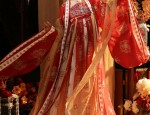The Belt of Splendor:Embroidering Cultural Heritage in Hanfu Fashion
In the realm of traditional Chinese attire, Hanfu, or Han clothing, represents a profound tapestry of cultural richness and historical continuity. Among the various embellishments that grace this ancient attire, the decorative waistband, or belt, holds a significant position, embodying both elegance and functionality.

The history of the Hanfu belt can be traced back to the Zhou dynasty, where it served not only to hold up the garment but also as a symbol of status and rank. Over the centuries, the design and patterns of these belts have evolved to reflect the changing tastes and cultural influences, yet always maintaining their inherent elegance and craftsmanship.
The belt in Hanfu fashion is often intricately crafted with intricate patterns and designs, ranging from simple geometric shapes to complex narratives. These designs are often embroidered with exquisite threadwork, using techniques like cross-stitching, running stitch, and knotwork. The use of vibrant colors and intricate patterns creates a visual feast that is both captivating and culturally significant.
Materials used in the making of these belts are equally significant. Silk, being the most prestigious material, was often used by the elite. However, with the passage of time and the evolution of craftsmanship, other materials like cotton and synthetic fibers have also been incorporated into the making of these belts. The use of these varied materials not only enhances the visual appeal of the belt but also makes it more durable and suitable for everyday wear.
The belt in Hanfu fashion is not just a decorative piece; it also serves a practical purpose. It helps in maintaining the fit of the garment and keeping it in place, especially in traditional clothing that often involves multiple layers and intricate designs. Additionally, the placement of the belt also provides a focal point, drawing attention to the wearer's waistline, enhancing their figure and overall appearance.
Moreover, the belt is often seen as a medium to display cultural and historical significance. Often, it bears symbols or motifs that reflect the wearer's values or cultural identity. These symbols could range from auspicious signs to traditional Chinese knots or even poetic phrases embroidered in calligraphic styles. These elements not only enhance the visual appeal of the belt but also serve as a means to pass on cultural wisdom and values from one generation to another.
In conclusion, the belt in Hanfu fashion is not just a piece of clothing; it is an embodiment of cultural Heritage and historical continuity. It reflects the wearer's identity, values, and sense of style. The intricate designs, vibrant colors, and skilled craftsmanship that go into making these belts make them not just a piece of clothing but a work of art that tells a story of rich cultural heritage. As Hanfu fashion continues to evolve and gain popularity, the belt will continue to grace this traditional attire, carrying forward the legacy of cultural excellence and craftsmanship.

 Previous Post
Previous Post






